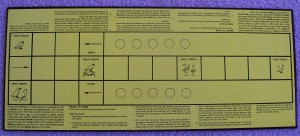The Royal Game of Ur or Game of Twenty Squares was unearthed in excavations in the 1920’s and is considered one the oldest complete board games.

Soon following the incredible 1922 discovery of Senet board games in the Egyptian Tomb of King Tutankhamen, other fabulous game boards were found in Ur. Sir Leonard Woolley had been excavating royal tombs of ancient Mesopotamia when the discoveries of the complete board games were made. The 1926-1927 unearthing of the boards, with implements, was an amazing find. A total of five splendidly crafted games were dug from the royal tombs and subsequently earned the game’s title of the Royal Game of Ur.
Although references of Senet and fragments of Senet game boards date back further than the 2600BC’s approximate dating of the tombs of Ur, the Royal Game of Ur is considered one of the oldest complete board games known. It was believed to have been widely played. A discovery of a board, on the reverse side of a Senet game in King Tut’s tomb in Egypt, would confirm this belief. Here, it was called Twenty Squares.
The Royal Game of Ur is a race game. Like Senet, instructions for how to play the game have been deduced from ancient references to the game. Irving Finkel, while working at the British Museum and translating cuneiform tablets, made such a deduction. A Babylonian tablet, dating to around 177BC, offered remarkable details about the game. Finkel used these inscriptions and was able to piece together enough information to form instructions on how to play like the ancients had.
There have been different layouts for the Game of Twenty Squares discovered. Some game boards, like the image above, had a group of squares on both ends; one of 12, the other side 6 (with two single squares in center). Other boards had the group of 12 squares on one end, but the center row was extended. This extended center row was 8 single squares long from the squares of 12. An example of this game board is shown below. The sample image is the reverse side of the 1977 King Tut’s Game by Cadaco Inc.

Whichever board is used, the objective for the game is the same. The goal is to be the first player to enter and remove all pieces from the board following a prescribed path. Specific rules for the game vary. From the book, The World of Games (1987), some brief instructions are as follows: (They differ from the instructions found written along the edges of the Cadaco inc. board)
Each player has seven pieces which move along the board according to the roll of three tetrahefron dice (pyramid shaped). In order to place a piece on the board, a player needs to throw a roll with the value of either a four or a five. Special squares on the board (the five rosettes seen in the first image) offer safety or allow more than one piece to be upon it.
If a player’s roll places his piece on a space which his opponent is positioned, the opponent’s piece is sent off the board (unless this space is a rosette). Each player’s piece must land on the last square by exact roll. From here, another four or five must be rolled in order to exit.
The first player with all pieces off wins the game.
The Royal Game of Ur is a mix of strategy and luck. Even though movement is determined by rolls of dice, the player does have the choice to split the roll and move separate pieces. This option provides players with just enough strategy to make it challenging. Fun and exciting to play, one realizes quickly that some of the best games were also the first games ever invented.
Sources:
Big Game Hunter, Time, reviewed January 15th, 2012
Botermans, Jack, The World of Games, Plenary Publications, 1987

Pingback: 1920’s Old Card Game of Stop Thief | All About Fun and Games
Pingback: Senet: The Oldest Board Game and Still Being Played » All About Fun and Games